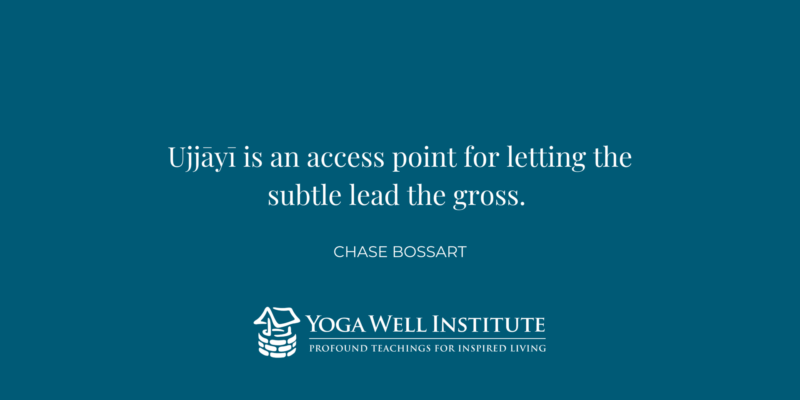WHAT IS UJJĀYĪ?
The first function of Ujjāyī
One of the most common breathing techniques in the practice of Yoga is called ujjāyī. This technique has two main functions.
The first is to make the breath tangible, to make it something that you can perceive.
During much of the day, we don’t even notice the breath—unless it is strained or forced, or when it stops suddenly, like when we’re startled.
Ujjāyī is a means of bringing the breath into our awareness by giving it a sound, and a feeling in the throat or the back of the mouth.
This enables us to not just notice the breath, but to also be aware of its quality.
- Is it long or short?
- Is it smooth or choppy?
- How consistent is it?
- Does it reduce or expand at any point?
This awareness provides an opportunity for us to adjust our breathing according to what we notice.
The second function of Ujjāyī
The second function of ujjāyī is to facilitate the lengthening of the breath.
Why is it important that the breath becomes tangible and lengthens? Because Yoga is a state of being. It is a description of an ideal way that your system—your body, breath, mind, behavior, and emotions— can operate. If you want to move toward a state of Yoga, you can do that by changing the way your system is operating. Making the breathing a little smoother and longer is an example of this.
Indeed, this is described in the second chapter of Patañjali’s Yogasūtra (II.50) as dīrgha-sūkṣmaḥ. Dīrgha means “long” and sūkṣma means “subtle.” Ujjāyī helps us accomplish that by providing feedback for what is happening in our breathing specifically, but also our entire system. The quality of the sound made in ujjāyī is the information that tells us if some adjustment to our breathing or our movements is needed. It lets us know if something should be changed in order to maintain the length and subtleness of the breath during our practice.

For example, while doing a series of utkaṭāsana (squats), if your breath becomes strained, it will show up in the sound and feel of ujjāyī. The ujjāyī will start to get choppy or uneven. With this awareness you can make an adjustment in how you are doing the āsana. That might mean lowering the arms between each squat or even stopping and resting until the breath becomes long and smooth again.
This is where practice gets really interesting because it ties into the deeper meaning of Yoga. With practice, ujjāyī is an access point for letting the subtle lead the gross. This is an important foundation for the real work of Yoga which is letting the most subtle thing within us, our spirit, lead us in our life.
Ujjāyī Breathing: Letting the Subtle Lead
Classically, the components of our system are listed as body, breath, mind, personality and emotions. The order is intentional, and conveys a number of truths. For one, it shows what is powerful in our system.
The body is easier to influence than the breath, which is easier to influence than the mind, and so on. Emotions are listed last because they are considered the most powerful material aspect of our system, and are also the most difficult to influence.
Another way to look at this is as moving from the gross to the subtle—breath is more subtle than body, attention is more subtle than breath, etc. During much of our day, the subtle follows the gross.
For example, if you walk up a few flights of stairs, especially if you aren’t used to that exertion, your breathing may become short and shallow, and you may become irritated. In other words, the state of your body affects your breath, which then affects your emotions.
One of the goals of Yoga is to reverse this pattern, and allow the subtle to lead our way.
Ujjāyī is an opportunity to practice this.
In terms of āsana (physical postures), we should try to initiate the breath first, then allow the movement to arise up out of the breath. This is not always easy because our pattern when doing things with the body, i.e. the gross, will be to use the body to do it. Using something as subtle as the breath as the foundation for which to do something with the body is a shift in orientation.
However, when we really pay attention to our ujjāyī, and adjust our movements to what the breath is telling us, it strengthens the pattern of the subtle leading the gross.
Ujjāyī is an important foundation of not only āsana, but also how we live our Yoga!
Breathing Lessons Near Me
Ready to explore and experience the potent influence of ujjāyī in your practice, and in your life? The Yoga Well Institute offers a variety of practices to support you in your ongoing practice and studies!
Looking for more?
The Yoga Well Podcast offers fresh perspectives on what Yoga is, how it transforms the body and mind, and liberates your life! Within the Yoga Well Podcast we will share teachings from the Viniyoga lineage of Mr. TKV Desikachar, while exploring Yoga as a way of being that is practiced both on the mat and in our everyday life.
When we understand Yoga as a lived experience, its practices and principles become available to anyone who is interested and invested in this life-long journey of self-inquiry and personal transformation. In this podcast your host Chase Bossart and other leaders in the Viniyoga lineage facilitate intimate discussions with a range of fascinating topics and perspectives exploring how Yoga turns the ordinary into the extraordinary.

Chase Bossart
M.A., C-IAYT, E-RYT 500
Executive Director of the Yoga Well Institute, Chase has been studying Yoga, Sanskrit, eastern philosophy and religion for nearly 30 years. He had the opportunity to personally study with Mr. TKV Desikachar and serve as a teacher at the Krishnamacharya Yoga Mandiram.




